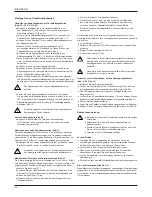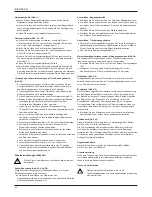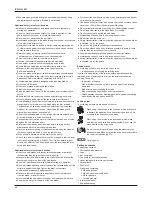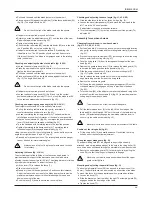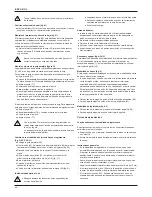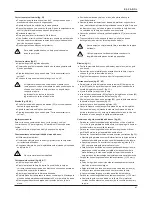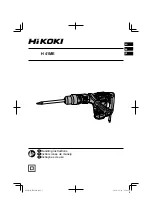
32
E N G L I S H
● Take care when grooving during the bench saw operation by using
appropriate guarding system. Slotting is not allowed.
Additional safety rules for mitre saws
● Make sure all locking knobs and clamp handles are tight before
starting any operation.
● Do not operate the machine without the guard in position, or if the
guard does not function or is not maintained properly.
● Never use your saw without the kerf plate.
● Never place either hand in the blade area when the saw is connected
to the electrical power source.
● Never attempt to stop a machine in motion rapidly by jamming a tool
or other means against the blade; serious accidents can be caused
unintentionally in this way.
● Before using any accessory consult the instruction manual.
The improper use of an accessory can cause damage.
● Select the correct blade for the material to be cut.
● Observe the maximum speed marked on the saw blade.
● Use a holder or wear gloves when handling a saw blade.
● Ensure that the saw blade is mounted correctly before use.
● Make sure that the blade rotates in the correct direction.
Keep the blade sharp.
● Do not use blades of larger or smaller diameter than recommended.
For the proper blade rating refer to the technical data. Use only the
blades specifi ed in this manual, complying with EN 847-1.
● Consider applying specially designed noise-reduction blades.
● Do not use HSS blades.
● Do not use cracked or damaged saw blades.
● Do not use any abrasive discs.
● Raise the blade from the kerf in the workpiece prior to releasing the
switch.
● Ensure that the arm is securely fi xed when performing bevel cuts.
● Do not wedge anything against the fan to hold the motor shaft.
● The blade guard on your saw will automatically raise when the arm is
brought down; it will lower over the blade when the arm is raised.
The guard can be raised by hand when installing or removing saw
blades or for inspection of the saw. Never raise the blade guard
manually unless the saw is switched off.
● Keep the surrounding area of the machine well maintained and free
of loose materials, e.g. chips and cut-offs.
● Check periodically that the motor air slots are clean and free of chips.
● Replace the kerf plate when worn.
● Disconnect the machine from the mains before carrying out any
maintenance work or when changing the blade.
● Never perform any cleaning or maintenance work when the machine
is still running and the head is not in the rest position.
● When possible, always mount the machine to a bench.
● If you use a laser to indicate the cutting line, make sure that the laser
is of class 2 according to EN 60825-1:2001. Do not replace a laser
diode with a different type. If damaged, have the laser repaired by an
authorised repair agent.
Additional safety rules for saw benches
● Do not use saw blades with a body thickness greater or a width of
tooth smaller than the thickness of the riving knife.
● Make sure that the blade rotates in the correct direction and that the
teeth are pointing to the front of the saw bench.
● Be sure all clamp handles are tight before starting any operation.
● Be sure all blade and fl anges are clean and the recessed sides of the
collar are against the blade. Tighten the arbor nut securely.
● Keep the saw blade sharp and properly set.
● Make sure that the riving knife is adjusted to the correct distance
from the blade - maximum 5 mm.
● Never operate the saw without the upper and lower guards in place.
● Keep your hands out of the path of the saw blade.
● Disconnect the saw from the mains supply before changing blades or
carrying out maintenance.
● Use a push stick at all times, and ensure that you do not place hands
closer than 150 mm from the saw blade while cutting.
● Do not attempt to operate on anything but the designated voltage.
● Do not apply lubricants to the blade when it is running.
● Do not reach around behind the saw blade.
● Always keep the push stick in its place when not in use.
● Do not stand on top of the unit.
● During transportation make sure that the upper part of the saw blade
is covered, e.g. by the guard.
● Do not use the guard for handling or transportation.
● Do not use blades with a body thickness greater or a width of tooth
smaller than the thickness of the riving knife.
● Consider applying specially designed noise-reduction blades.
● Always keep the push stick in its place when not in use.
● During transportation make sure that the upper part of the saw blade
is covered, e.g. by the guard.
Residual risks
The following risks are inherent to the use of saws:
– injuries caused by touching the rotating parts
In spite of the application of the relevant safety regulations and the
implementation of safety devices, certain residual risks cannot be
avoided. These are:
– Impairment of hearing.
– Risk of accidents caused by the uncovered parts of the rotating
saw blade.
– Risk of injury when changing the blade.
– Risk of squeezing fi ngers when opening the guards.
– Health hazards caused by breathing dust developed when sawing
wood, especially oak, beech and MDF.
Labels on tool
The following pictograms are shown on the tool:
When using the machine in the mitre saw mode, make sure
to operate the trigger switch when switching on and off. Do
not operate the switchbox in this mode.
When using the machine in the bench saw mode, make
sure that the riving knife has been mounted. Do not use the
machine without the riving knife.
Do not use the riving knife when using the machine in the
mitre saw mode. Make sure that the riving knife is secured in
the upper rest position (fi g. F3).
Carrying point.
Package contents
The package contains:
1 Partly assembled machine
4 Legs
1 Box containing:
1 Top guard for bench saw position
1 Under-table guard for mitre saw position
1 Parallel fence
1 Push stick
1 Plastic bag containing:
4 M8 locking knobs
4 M8 x 50 mushroom head bolts
4 D8 fl at washers
1 Locking grommet
1 Instruction manual
1 Exploded drawing
Summary of Contents for DW743
Page 1: ...DW743 ...
Page 3: ...3 3 A2 A1 10 11 8 7 14 13 12 5 6 4 3 2 9 1 21 19 20 18 14 15 16 22 17 ...
Page 4: ...4 4 A4 A5 A3 27 24 25 26 23 22 29 28 34 30 31 33 32 35 ...
Page 5: ...5 5 A8 B A6 A7 29 36 37 38 X ...
Page 6: ...6 6 C1 E1 D C2 E2 47 48 49 18 46 52 51 53 54 50 20 2 55 56 23 ...
Page 8: ...8 8 J2 J1 K1 K2 L1 L2 M N 7 72 74 22 73 75 16 12 76 77 2 20 3 8 mm 62 16 16 25 76 ...
Page 9: ...9 9 O P Q R S T U 77 78 26 79 80 81 V1 82 81 ...
Page 10: ...10 10 V3 W 84 83 85 85 V2 ...
Page 137: ...137 ...
Page 138: ...138 ...
Page 139: ...139 ...









